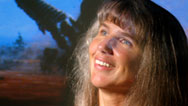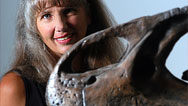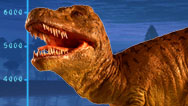T. Rex Blood?
- Posted 07.24.07
- NOVA scienceNOW
(This video is no longer available for streaming.) Paleobiologist Mary Schweitzer has defied the long-held belief that it is fruitless to search for preserved soft tissues in dinosaur remains. Most experts thought that such structures would have decayed and vanished long ago, but Schweitzer has found evidence of delicate structures such as blood vessels and red blood cells that have survived for millions of years.
Transcript
T. Rex Blood?
PBS air date: July 24, 2007
NEIL DEGRASSE TYSON: Hello. I'm Neil deGrasse Tyson, your host for NOVA scienceNOW.
Most of what we know about ancient life—and I'm talking millions of years old—comes from these things, fossils. You know, they're actually rocks. Over time, the bone and tissue has been replaced by minerals. But there's only so much you can learn from a rock. Think about how much more you could learn if, instead of a rock, what you found was the real thing.
Peter Standring met some researchers who've uncovered some rare remains.
PETER STANDRING (Correspondent): Bones tell us almost everything we know about dinosaurs: the fantastic variety of species, their titanic size, their sheer power. The frustrating thing is that there's still so much we'd like to know that dinosaur bones haven't told us. Were they warm-blooded or cold-blooded? How different were they from modern reptiles? To solve these biological questions, today's paleontologists are starting to explore radically new clues from dinosaur skeletons. Kristi Curry Rogers cuts into their bones to examine the pattern of what was once living tissue.
Is it sort of like CSI for dinosaurs?
KRISTI CURRY ROGERS: It can be, sure. Sometimes it's kind of a different method of detective work. We can see, in these cross-sections of bones, evidence of pathology, evidence of dinosaur disease and evidence of dinosaur bones breaking and healing themselves. All of that stuff is available via the inside look at a dinosaur bone.
PETER STANDRING: Analyzing the rock that entombed dinosaur fossils is key to understanding how they were preserved, which is the work of Kristi's husband, geologist Ray Rogers.
RAYMOND ROGERS (Macalester College): And I'm there to try to place the discoveries in context, to try to find clues as to where may be best to look for fossils. We've been pretty lucky in Madagascar.
PETER STANDRING: For the last decade, the African island has offered Ray and Kristi Rogers a spectacular excavation site. They work in an area of remote grasslands where dinosaur bones literally cover the ground, an ancient graveyard where an unusually large number of dinosaurs died and were entombed by mudflows that preserved their bones.
RAYMOND ROGERS: The preservation is unbelievable. The quality of the material is exceptional. This is a piece of bone from the Madagascar locality. It, in many regards, doesn't even look like a fossil; it's unstained. It's very light. It's not heavily, densely filled with minerals. You look at a dinosaur bone in a museum and it's brown, it's black, it's heavy as can be.
PETER STANDRING: Heavy because fossils are no longer hollow bones. Buried in the earth, empty channels inside the bone fill up with minerals, becoming dark and stained, hard as stone. In some cases, the bone tissue itself is completely replaced by minerals. It's difficult to probe dinosaur biology with bones that have turned to rock, but the Madagascar fossils were sealed in a clay-rich mud, preventing many of the chemical changes that happen to most dinosaur bones.
RAYMOND ROGERS: This is typical of the Madagascar material. It's not heavily stained. It's not been invested with iron, with manganese. It doesn't look like a typical fossil. If you didn't know, you might think you're picking up a cow bone today, a bleached cow bone.
KRISTI CURRY ROGERS: I think this piece might be good, or maybe...
PETER STANDRING: The Madagascar bones are so perfectly preserved that Ray and Kristi wondered if they might conceal clues about how these dinosaurs lived, and why so many of them died in the same place. To find out, they turned to their colleague, Mary Schweitzer, a paleobiologist, whose study of ancient cells and tissues might solve the mystery.
MARY HIGBY SCHWEITZER: We know that dinosaurs had to have cells—bone cells, and muscle cells, and gut cells, and brain cells—and that's one of the reasons we can study them, even though they are extinct.
PETER STANDRING: Schweitzer's career defined itself in her native Montana when she was preparing one of the largest skeletons of a Tyrannosaurus rex ever found.
MARY HIGBY SCHWEITZER: I was working on the leg bones. And as I worked, I noticed a bunch of stuff. It was like, you know, "This bone, it's hollow inside." And I was looking at this thing thinking, "This is really interesting."
PETER STANDRING: It was the inside of the T. rex bone that fascinated Schweitzer, who made thin sections out of it. And in these cross-sections of fossilized bone, she saw something that she and everyone else had thought was impossible: round structures that looked like red blood cells, dinosaur blood cells.
MARY HIGBY SCHWEITZER: Inside those channels where the blood vessels would have run were these little round red structures that were all kind of lined up like a train. And they were bright red and translucent. Nobody else had seen anything like that before.
PETER STANDRING: The very idea of blood cells in a 70-million-year-old bone was more than unconventional, it was radical.
DEREK BRIGGS (Peabody Museum of Natural History, Yale University): Nobody was imagining that dinosaurs might have had preserved soft tissues.
PETER STANDRING: Derek Briggs is curator of invertebrate paleontology at the Peabody Museum at Yale University.
So along comes Mary Schweitzer, and she's starting to look inside dinosaur bones and has made this startling discovery about the presence of red blood cells. What was your initial reaction to that?
DEREK BRIGGS: Oh, I think the same reaction as everybody's, that this was totally improbable, she'd perhaps misinterpreted the evidence or was exaggerating the potential for what she was seeing.
PETER STANDRING: So, skeptical, at first?
DEREK BRIGGS: Oh, yeah, definitely.
PETER STANDRING: Paleontology has been around for some time.
DEREK BRIGGS: One of the oldest professions.
PETER STANDRING: One of the oldest professions. Has anybody else that you know of found similar things inside a bone?
DEREK BRIGGS: No.
PETER STANDRING: Why do you think it didn't occur to anybody?
DEREK BRIGGS: Because we have this clear understanding that part of all biological cycles involves decay. I mean, nature is set up to break down that material and recycle it. So it's just improbable that those kinds of very delicate structures would survive, particularly for millions of years.
MARY HIGBY SCHWEITZER: When you think about it, the laws of chemistry and biology and everything else that we know say that it should be gone. It should be degraded completely.
PETER STANDRING: But Schweitzer kept searching for organic remains where no one had thought to look before. Her mentor is Jack Horner, one of the most famous dinosaur hunters in the world. When his team found another beautifully preserved T. rex in the remote Montana Badlands, the massive leg bone had to be broken in half for transport, and Schweitzer got to test fragments from deep inside the bone.
MARY HIGBY SCHWEITZER: The T. rex bone was filled with a very unique bone tissue. When I turned it, you know, like that, and looked down on it, and saw this tissue that you can see right there in cross-section, I knew what it was.
PETER STANDRING: It's called medullary tissue, and it's what female birds build up inside their bones as a source of calcium for the eggs they lay. All dinosaurs laid eggs, and it made sense to Schweitzer that female dinosaurs produced the same kind of bone tissue. It looks different from the surrounding bone, and it meant the T. rex had to be a mother, expecting a clutch of dinosaur eggs.
MARY HIGBY SCHWEITZER: It was really exciting for me. I thought, "There is nothing in my career that could possibly be cooler than being able to identify the first pregnant T. rex."
PETER STANDRING: No one had ever identified medullary tissue in a dinosaur bone before. But, to be sure, Mary Schweitzer directed her lab assistant to soak the bone sample in an acid solution to reveal its structure so she could study it. What happened next would change the way scientists thought about fossils forever.
JENNIFER WITTMEYER (North Carolina State University): As I was looking in the microscope, the medullary material was no longer hard. And, um, what was left was this curled piece of tissue that I was using forceps to try and flatten out. And when I poked into it, it was, it was spongy. It was flexible and soft tissue.
PETER STANDRING: Flexible tissue? From a 68-million-year-old dinosaur?
MARY HIGBY SCHWEITZER: Blood vessels, transparent, hollow, pliable, flexible branching blood vessels that contained small, round, red microstructures floating in the vessels. I said, "This is not possible. Do it again."
We got another piece of bone, we put it in the solution, we waited two or three or four weeks, looked again...more blood vessels. We must have repeated that with probably 17 or 18 different fragments of bone.
PETER STANDRING: As soon as Schweitzer's discovery of dinosaur soft tissue was published, people thought of one thing: could we get a real life Jurassic Park? No paleontologist believes we could ever get enough ancient DNA to clone a dinosaur. But could fragments of genetic material be extracted from this new tissue?
KRISTI CURRY ROGERS: I think anything is possible. If there are blood vessels and red blood cells preserved in a dinosaur, I think it's quite possible that there will be DNA there as well.
PETER STANDRING: Even without DNA, proteins from soft tissue could begin to answer real mysteries about dinosaur biology: evidence of warm blood versus cold blood, whether the large body size of dinosaurs is linked to large cell size. The Rogers have a theory that dinosaur mass deaths in Madagascar might have been caused by water poisoned by algae. This poisoning event wouldn't show up in hard bone, but they might be able to test the theory with dinosaur blood cells.
RAYMOND ROGERS: This structure...I mean, there's a lot of structure there.
KRISTI CURRY ROGERS: Yeah.
RAYMOND ROGERS: If there's anything in this tissue that Mary finds that actually can trace a toxin, that would be fantastic—things like disease, diets; things like that from soft tissues that you can't extract from hard tissue from true fossil bone.
PETER STANDRING: The hope is that the Madagascar fossils will allow Mary to find more dinosaur tissue. So Ray and Kristi gather fragments of their best preserved fossils. A few days later, the samples arrive at Schweitzer's lab at North Carolina State University. She uses the same technique that yielded soft tissue in the T. rex bone, soaking the fragments in a mild acid that dissolves away the mineral part of the bone. But will she be able to find the same internal structures in Ray and Kristi's fossils?
KRISTI CURRY ROGERS: There's only so much you can know from looking at the outsides of bones, but when there's soft stuff inside, the possibilities become almost endless.
This is a single cell.
PETER STANDRING: Through photos from her microscope, Mary hits the jackpot: pieces of biological history.
MARY HIGBY SCHWEITZER: Now, see, this is really cool. It's what looks like vessels to me, connected together, transparent. And you can see right there. You can see the branch points and stuff.
PETER STANDRING: The Rogers are seeing inside their collection of fossil bone as they've never seen it before...structures that appear to be the vessels that once carried blood inside a dinosaur's body.
MARY HIGBY SCHWEITZER: This is hooked together. There's a transparent region.
RAYMOND ROGERS: Yeah, it's a tube with stuff inside of it.
PETER STANDRING: Branching, hollow, organic material that scientists thought could never be preserved in a dinosaur fossil.
KRISTI CURRY ROGERS: That's amazing, that this is from 65-, 70-million-year-old bone.
PETER STANDRING: It's too early for these structures to reveal details like dinosaurs dying from poisoned water, but dinosaur soft tissue opens a door that no scientist thought even existed until Schweitzer's work changed that assumption.
DEREK BRIGGS: There's little doubt in my mind that what she has discovered are internal structures in dinosaur bone. And we may look back and say, "Well, this sort of approach to looking at fossil vertebrate biology has revolutionized the field." But we won't know that for some time yet.
RAYMOND ROGERS: To get in there and to find soft tissues, to find blood vessels, to find cells, it is an opportunity to go to places that we never thought we would be venturing just 10 years ago.
Credits
T-Rex
- Edited by
- Stephen Mack
- Produced and Directed by
- Dean Irwin
NOVA scienceNOW
- Executive Producer
- Samuel Fine
- Executive Editor
- Neil deGrasse Tyson
- Senior Series Producer
- Vincent Liota
- Supervising Producer
- Stephen Sweigart
- Editorial Producer
- Julia Cort
- Development Producer
- Vinita Mehta
- Senior Editor
- David Chmura
- Production Assistant
- Alison Snyder
- Production Secretary
- Fran Laks
- Animator
- Brian Edgerton
- Compositor
- Yunsik Noh
- Music
- Rob Morsberger
- Associate Producers
- John
Pavlus
Gitanjali Rege - Camera
Andreas Bremer
Brian Dowley
Mark Falstad
Edward Marritz
Dusty Powers
Brett Wiley- Sound Recordists
-
Sven Ehling
Heidi Hesse
Brooks Lester
Mark Mandler
Paul Rusnak
George Shafnacker - Co-Producer/Researcher for Epigenetics
- Ethan Herberman
- Animation and Graphics for Epigenetics
- Sputnik Animation
Dan Nutu, Fotografis - Colorist
- Jim Ferguson
- Audio Mix
- Jim Sullivan
- NOVA scienceNOW series animation
- Edgeworx
- Archival Material
- Arlie Petters
The Belize Times
European Space Agency
Frank Summers/Space Telescope Science Institute
Great Belize Productions Ltd. – Channel 5
Les Todd/Duke University
M. Kornmesser and L.L. Christensen/Hubble European Space Agency Information Centre
NASA
Observatories of the Carnegie Institution of Washington - Special Thanks
- Hirshhorn Museum and
Sculpture Garden
Hrana Janto
International Spy Museum
Museum of the Rockies - Neil deGrasse Tyson
- is director of the Hayden Planetarium in the Rose Center for Earth and Space at the American Museum of Natural History.
- NOVA Series Graphics
- yU + co.
- NOVA Theme Music
- Walter Werzowa
John Luker
Musikvergnuegen, Inc. - Additional NOVA Theme Music
- Ray Loring
- Post Production Online Facility
- The OutPost
- Closed Captioning
- The Caption Center
- NOVA Administrator
- Ashley King
- Publicity
- Eileen Campion
Anna Lowi
Yumi Huh
Lindsay de la Rigaudiere - Researcher
- Gaia Remerowski
- Production Coordinator
- Linda Callahan
- Paralegal
- Raphael Nemes
- Talent Relations
-
Scott Kardel, Esq.
Janice Flood - Legal Counsel
- Susan Rosen Shishko
- Assistant Editor
- Alex Kreuter
- Associate Producer, Post Production
- Patrick Carey
- Post Production Supervisor
- Regina O'Toole
- Post Production Editor
- Rebecca Nieto
- Post Production Manager
- Nathan Gunner
- Business Managers
- Joseph P. Tracy
Carla Raimer - Producer, Special Projects
- Lisa Mirowitz
- Coordinating Producer
- Laurie Cahalane
- Senior Science Editor
- Evan Hadingham
- Senior Series Producer
- Melanie Wallace
- Managing Director
- Alan Ritsko
- Senior Executive Producer
- Paula S. Apsell
This material is based upon work supported by the National Science Foundation under Grant No. 0229297. Any opinions, findings, and conclusions or recommendations expressed in this material are those of the author(s) and do not necessarily reflect the views of the National Science Foundation.
NOVA scienceNOW is a trademark of the WGBH Educational Foundation
NOVA scienceNOW is produced for WGBH/Boston by NOVA
© 2007 WGBH Educational Foundation
All rights reserved
Participants
- Derek Briggs
- Peabody Museum of Natural History earth.geology.yale.edu/people/moreinfo.cgi?netid=deb47
- Kristi Curry Rogers
- Science Museum of Minnesota www.smm.org/paleontology/rogers/
- Mary Higby Schweitzer
- North Carolina State University www4.ncsu.edu/~mhschwei/NCSU_Paleontology/Mary_Schweitzer.html
- Raymond Rogers
- Macalester College
- Peter Standring
- Correspondent
- Jennifer Wittmeyer
- North Carolina State University
Related Links
-

T. Rex Blood?: Expert Q&A
Paleontologist Mary Schweitzer answers questions about the preservation of soft tissues in ancient fossils.
-

Inside the Bones
See what Mary Schweitzer's team found within the primordial remains of everything from a mammoth to a Triceratops.
-

T. Rex
An astonishing adolescent growth spurt accounts for T. rex's enormous size.
-

Growing Up T. Rex
In this interactive, see how lines on the rib of a T. rex reveal both its age and its appetite.
-

Dinosaur Plague
Insects caught in amber spark a controversial theory about what killed the dinosaurs.
-

T. Rex Blood?
Learn about the surprising finding of preserved soft tissue in dinosaur fossils.



